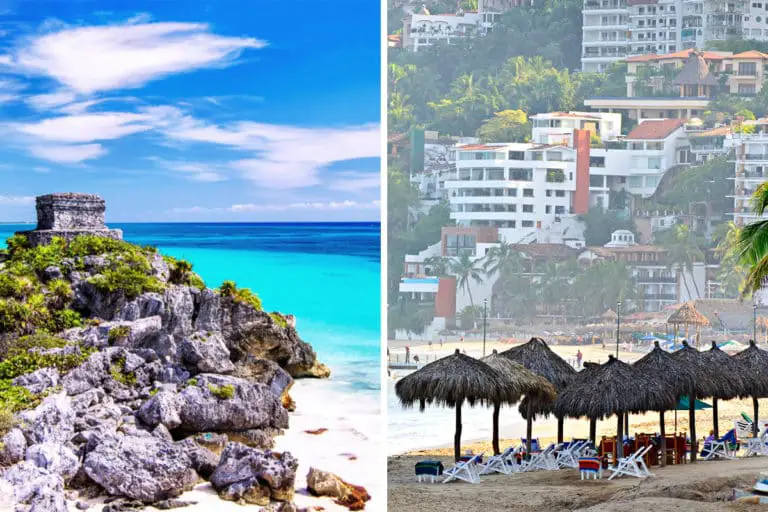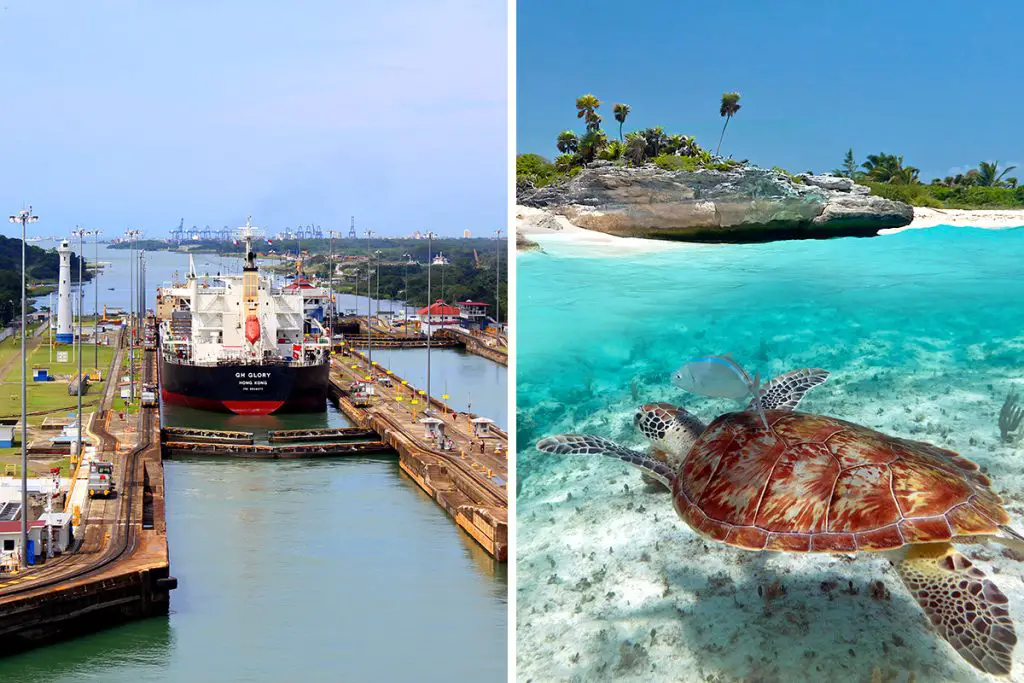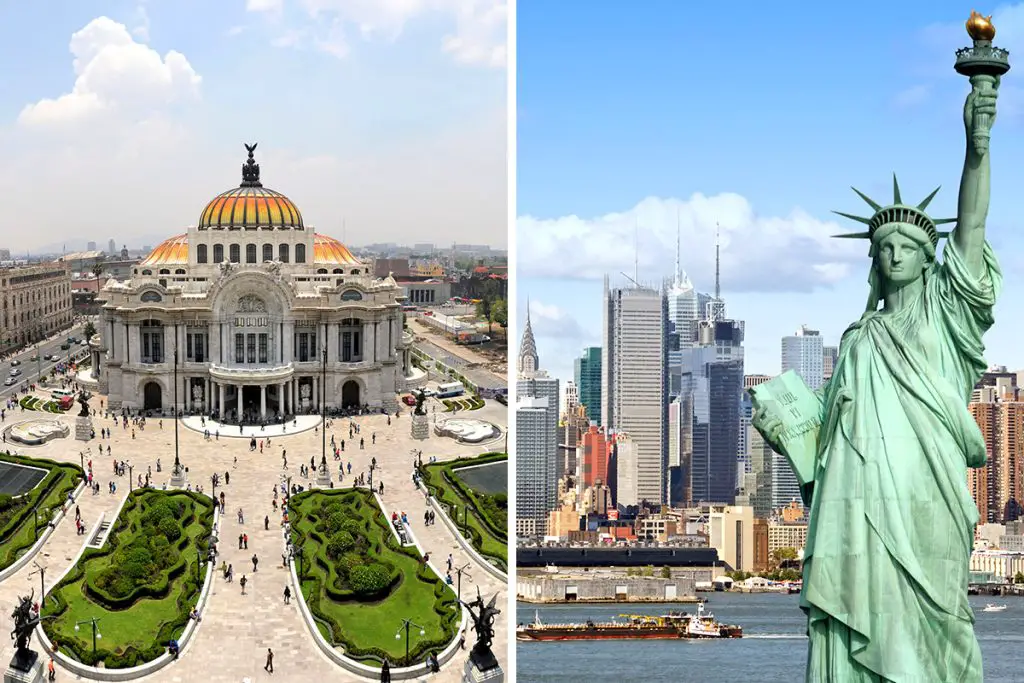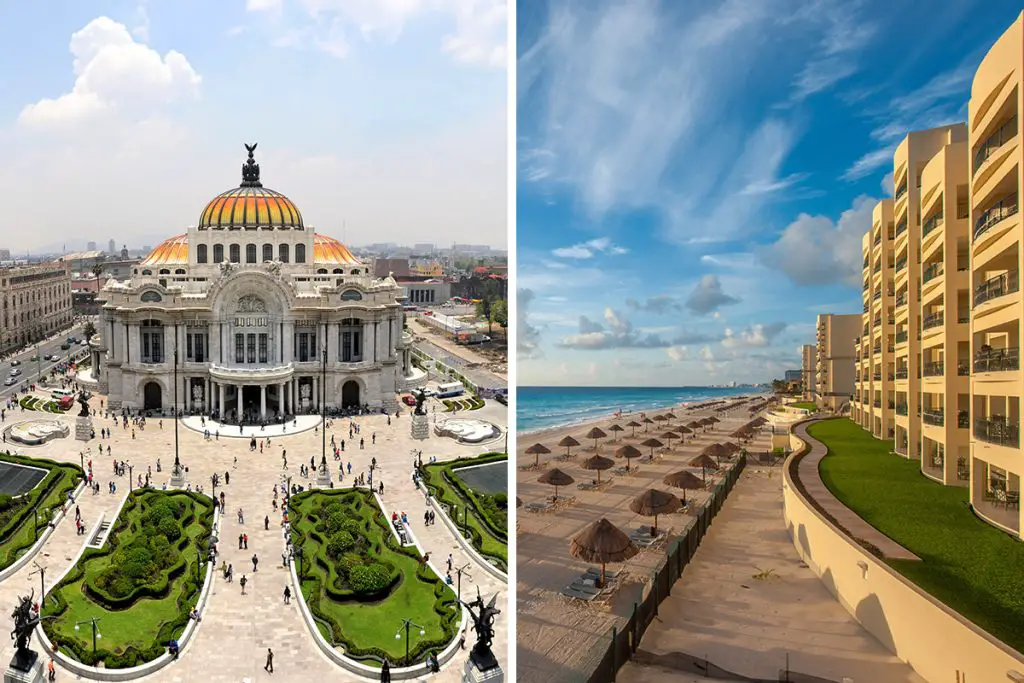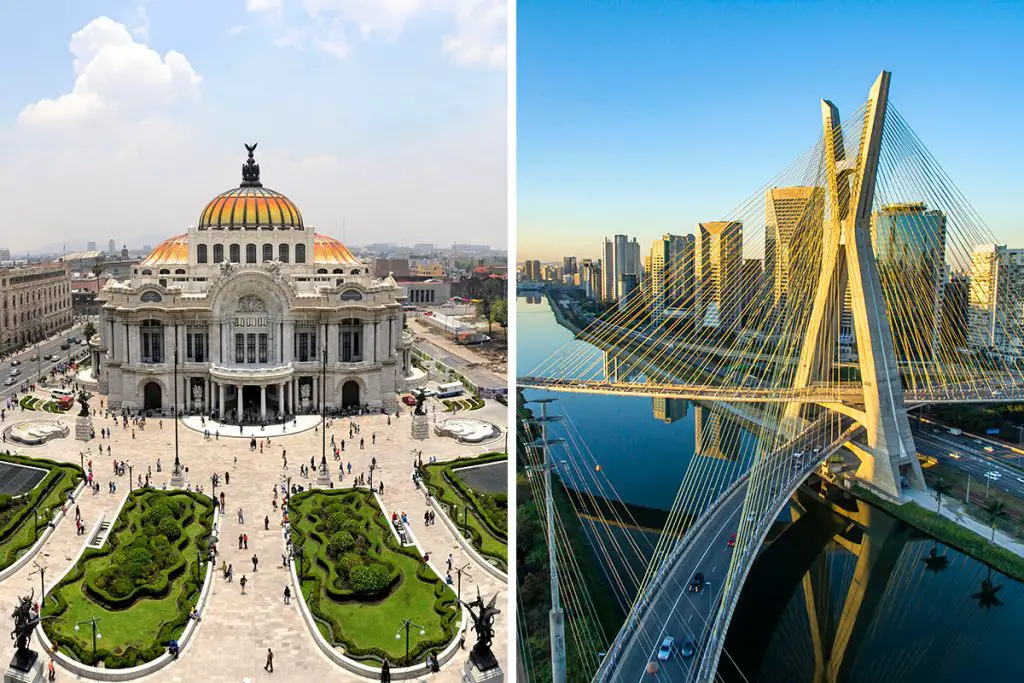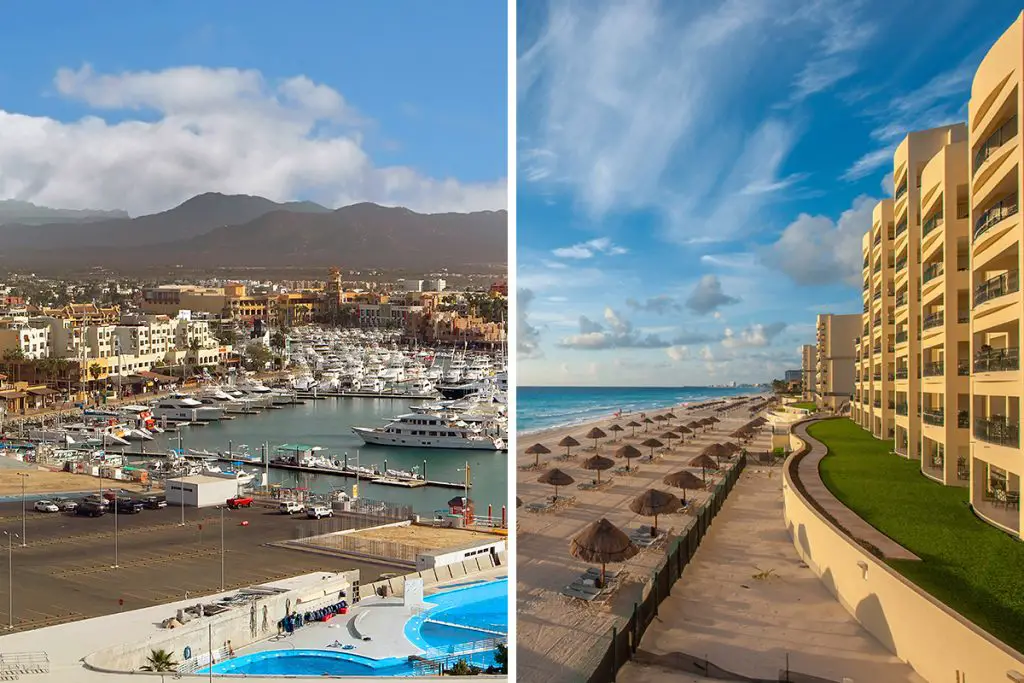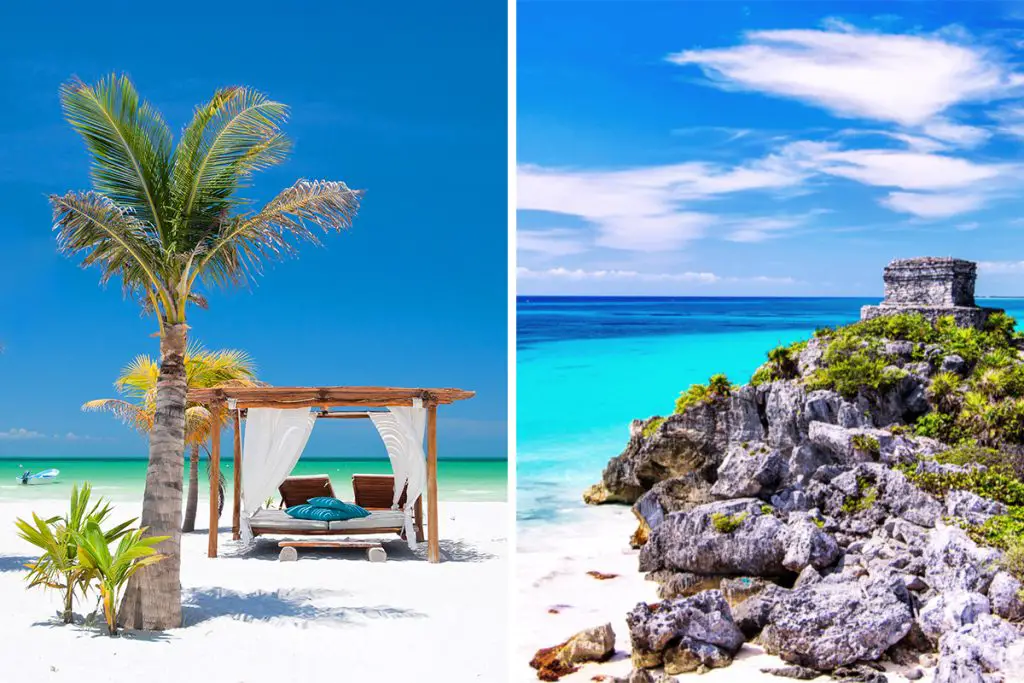Tulum is the darling of the Riviera Maya best for the curious yet R&R-hungry crowd. Puerto Vallarta, or PV for short, generously balances the upscale, with the genuinely gritty edges of a Mexican seaside city. Whichever you choose, expect to get to know Mexico a little bit more.
Tulum
A true Mexican treasure, Tulum best represents Mexican culture and history. The town is known for its ruins and striking beaches. You can most certainly have your mind blown and your wanderlust satisfied here. You can have all the mystical charms in this perfectly balanced Riviera Maya town.
From ruins to idyllic beaches, lush jungles to high-end dining, you can expect to find a little bit of everything in Tulum. However, if you’re heroic enough to brave the large curious crowds, Tulum is a dream.
What Makes Tulum Unique?
Ancient Ruins
Speckled throughout the magical Yucatan Peninsula, ancient ruins are almost a common sight. It is not a surprise that a region as gifted as the Riviera Maya is also teeming with them. And one of the most well-loved jewels of the Riviera Maya, Tulum houses one of the most iconic in Mexico. The ruins in Tulum are often the stuff of postcards.
Perched on the edge of a cliff overlooking the Caribbean, the Mayan ruins in Tulum are one of the most visited sites on the peninsula. The ancient walled city was once a major trading and religious center of the Mayan world. It even perhaps holds the same value as Coba and Chichen Itza.
Tulum was designed to be a coastal fortress, with steep seaside cliffs on three sides providing defense from the East. It even has a massive limestone wall surrounding the rest of the city.
Thanks to this, Tulum holds a valuable position in the Yucatan back in the heyday of the Maya. Here, goods like cotton, cacao beans, and other minerals are traded.
If you’re one for a more laid-back trip, the ruins may spell a drag for you because the foot traffic in Tulum’s iconic ruins can be dramatic. Expect to see throngs of people in every inch of the ruins making it one of the most infamously tourist-saturated places on the Riviera.
Here are some of the must-visit structures in the Tulum ruins:
El Castillo
El Castillo is the tallest and most imposing structure in the ancient city. It both functions as the ruins’ main pyramid and a lighthouse guiding ancient pre-Colombian boats safely to shore.
El Castillo is surrounded by a marked path, making it easy to see from all angles. However, Climbing or entering the structure is no longer allowed. This ban is meticulously enforced to prevent further erosion of the pyramid.
Temple of the Frescoes
Tulum’s Temple of the Frescoes held significant social and religious significance. This is the best-preserved section of the Tulum Ruins, and it contains many ancient mysteries. It is one of the most magnificent structures since there is a mural with colored paint that is still in its splendor.
It is a tiny two-story building placed just in front of the El Castillo. Originally, this temple was used as an observatory for tracking the Sun’s journey.
House of the Halach Uinic
Each Mayan city was ruled by a high-priest known as “Halach Uinic,” who was the Mayan Kuchkabal’s supreme leader. A Kuchkabal is a form of government in pre-Columbian times. In Maya times, he was the one who wielded all power in the city and appointed all administrative offices.
Among the ruins of Tulum, this home is one of the most well-preserved. A magnificent mural of the diving God hangs above the house’s entrance, which is now protected by a thatched roof.
Resident Wildlife
Tulum may often feel touristy thanks to its relative fame, but you can still revel in the rich wildlife in the forests around houses. You can find a wide variety of flora and fauna just outside the doorstep of your Tulum base. From scorpions to jaguars and spider monkeys you can expect to find Tulum to be even more interesting beyond its ruins and beaches.
If you want to encounter many of these animals, you can visit the Si’an Kaan biosphere, just inside Tulum.
It is one of the largest ecologically diverse areas in the country. The biosphere includes tropical forests, mangroves, marshes, and a marine section. It even encompasses a part of the Mesoamerican Barrier Reef.
Thanks to these features, the biosphere houses over 300 different bird species, and a diverse set of land animals. You can even spot jaguars and spider monkeys here. You can also snorkel around the reef system and witness bursting marine life. Tours are available the entire day, and may even provide transportation from your hotel.
Tulum Beaches
Tulum’s beaches are so beautiful they usually end up in promotional images for Mexico, some are even found on pages of travel magazines. The town’s beaches are arguably some of the most picturesque in the Riviera, and even in the whole world. Thanks to Tulum’s soft white sand and the vast beach stretches, it is definitely its most famous selling point.
Here are some of the most recommended spots:
Las Palmas
Las Palmas has a beautiful stretch of sand with calm turquoise waves. A rocky patch to the far right and incredibly silky soft sand to the left define this relatively quiet beach.
The water is the same baby blue as the others, but what sets it apart from the others is the relative serenity and quiet. You can even rarely see vendors here, so you might want to pack your necessities if you’re planning to stay for long hours.
Playa Ruinas
Perhaps the most iconic beach in town, Playa Ruinas has helped put Tulum on the tourist map of Mexico. The beach’s all-time famous appeal is the watchtower ruin perched on a cliff overlooking the beach below.
But with its fame comes a certain downside, you’re never going to have this picturesque beach all to yourself. The ruins above are one of the most visited archeological sites in Mexico, and visitors usually make the beach an additional stop.
Playa Paraiso
This is the most famous, and most-visited beach in Tulum. Playa Paraiso boasts an expansive stretch of powder-white sand and turquoise-blue beaches. The famous beach is what you usually see on promotional images of Tulum, and even for Mexico. It is that beautiful.
While Tulum may have upscaled thanks to the fame and recognition it is garnering, surprisingly, Playa Paraiso remains rustic and unchanged. You can still see palapas here, and sunbeds that you can rent for 10 USD a day.
The waters here are extremely clear and ideal for swimming, snorkeling, and diving. But, if you plan on doing any of these sports, bring your own equipment. This beach is also a good spot to see wildlife such as birds, iguanas, and possibly a few turtles.
Recent Gastronomic Boom
Tulum has developed an astounding diversity of dining options due to the constant waves of sunseekers. The natives take pride in their culinary prowess. But in recent years, several foreign chefs and restaurateurs have joined them. Now you can find samples from a vast culinary explosion, from high-end dining to street food flares.
You can sample dishes from Europe to the Caribbean in various places that have set up shop in town. Visit places such as Meze, Hartwood, Posada Margherita, and Loyal Order for a more western palate. And if you want to sample authentic local food, try out various homegrown food places. Visit Antojitos la Chiapaneca, and Plasma Central, Tulum’s first food truck park.
Kaan Luum Lagoon
Considered Tulum’s hidden treasure and its most underrated draw yet. The Yucatan Peninsulas’s premier lagoon is a tropical paradise to behold. Its most notable feature is the cenote in the center with a hue of cobalt blue. The water’s color contrasts with Laguna Kaan Luum’s green outer edges of shallow water.
The fact that the large, strange hole in the middle of the lagoon is actually a cenote adds to its allure. It’s thought to reach a depth of 80 meters or 262 feet. Some locals even believe the cenote’s sediment has medicinal benefits, so people visit the lagoon to make their own mud baths. Around this mint-green swimming hole are lush green jungles and tropical plants.
Apart from bathrooms and a few thatched tents providing shade, the entire region is devoid of modern amenities. You’ll feel like you’ve stumbled into a hidden sanctuary in the heart of Mexico, filled with natural beauty and rustic charm.
Tulum Pueblo
The town’s rustic and authentic Tulum Pueblo is a stark contrast to Cancun and Playa del Carmen’s high-street scenes. The Pueblo’s true Mexican charm is perhaps one of Tulum’s best draws. With the influx of international interests, the town has managed to preserve its authentic Mexican charm. Perfectly balancing it with its new-age upscales.
In Pueblo, you’ll find a variety of local and homegrown businesses still thriving thanks to tourism. The town’s building has even retained its authentic and rustic facades despite the developments. Not to mention, the town’s food scene which is perhaps one of its must-tries. From street food and high-end dining to staple food shacks, you can have a bit of everything here.
Just a few meters outside of the Pueblo, you can be greeted by a lush forest, full of undisturbed wildlife. If you’re planning on staying in Tulum, and not just a day trip, you have a variety of options for accommodations. You have local boutique hotels, international stays, and even simple and charming hostels and homestays.
Thanks to all of these charms, plus the ruins and the incredible beach, Tulum has recently been designated as a Pueblo Magico, or a Magic Town. Tulum is perhaps one of the most visited places in Mexico not just in the Riviera Maya.
Puerto Vallarta
One of Mexico’s most authentic jewels, Puerto Vallarta has managed to enthrall waves of curious travelers every year to more than just its interesting beaches and chic hotels but for its cultural value. Puerto Vallarta has indeed proven that its authentic scene is its best draw.
The city can blend and balance its cultural roots, chic and developed areas, and rugged beaches together. Puerto Vallarta provides a different take on Mexico’s tourism scene. Making it one for the open-minded and true Mexico-loving traveler.
What Makes Puerto Vallarta Unique?
The City’s Beachside Heart
Sitting just along Mexico’s gilded Pacific coast, Puerto Vallarta is blessed with miles and miles of shoreside beauty. However, PV, as it is lovingly shortened, offers a different take on Mexican beach delights. Notable for a warmer hue, the sands across the city’s coast gleam a certain gold when hit by the sun. A distinct digression from the Caribbean’s famous white sands.
However different, these beaches hold unique beauty on their own, as many of which are some of the most well-loved beaches in the country.
Another unique twist to this part of Mexico is that it lacks an expansive continuous stretch of beaches. Rather, PV has broken, and often rocky beaches, but gilded, swimmable, and picturesque nonetheless.
Many of PV’s best, and most iconic beaches sit south of the city center, in an area called the Zona Romantica. A small trip south, about 30 minutes or so will lead you to the following icons:
Los Muertos
The most famous beach in all of PV, Los Muertos is the place for everyone, from solo backpackers to families, tourists, or locals. Playa Los Muertos is accessible if you’re coming from downtown. Just walk south along the iconic El Malecon, and you’ll see it. Crowded as usual.
The beach is a famous congregation spot where people tend to meet, and where tourists get to know the city a little bit more. Thanks to its constant crowd, Playa Los Muertos is dynamic, fun, and entertaining. You can swim, relax, drink, and if you come here late in the afternoon, you can enjoy the sunset.
Punta Negra
Apart from its obvious beauty, Punta Negra is a star thanks to its swimmable conditions. Perfect for families with young children. The water in Punta Negra is noticeably calm and gentle, and the waves are almost like in swimming pools. Apart from swimming, and relaxing, you can also snorkel from Punta Negra – another perk of its excellent conditions.
Plus, the beach is clean and quaint, making it best for downtime and relaxation. Punta Negra is the best option if you want to get away from the crowds of Playa Los Muertos and Conchas Chinas.
Conchas Chinas
Conchas Chinas sits interestingly between rainforest and the ocean, making it a fascinating place to visit. Imagine taking a dup having a contrasting backdrop of the lush Sierra Madre and the Pacific Ocean. Located just 30 minutes south of the downtown area, Conchas Chinas is another PV favorite.
The beach is also nearby food and drink establishments, making it an ideal spot for a day trip in PV. You can find various restaurants here that serve various authentic specialty dishes.
Playa Palmares
Just like Conchas Chinas, Playa Palmares also boasts contrasting views of the mountain and forests on one side and the ocean on the other. Playa Palmares’ vibe is perfect for friends and family looking to just chill and hang out on a less crowded beach.
You can also buy souvenirs and food from the occasional vendors that come here. From trinkets, snacks, fresh catch and fruit, all are available for you to buy right at the entrance.
Playa Palmeras just like Puerto Los Muertos is easily accessible. Just a short 4.6 miles or 7.5 km from the Zona Romantica, you can get here in just 17 minutes. Plus, the view is going to the Playa is a spectacle in itself as well.
El Malecon
PV’s Zona Romantica or the downtown area is sparse with beaches, just rocky shores not safe for swimming. However, the famous Grand Malecon makes up for the lack of beaches in this part of the city. Spanning from the north to the central areas, El Malecon is the city’s most defining feature.
An oceanfront promenade that is as long as a mile consists of everything you could ever need to get familiar with the magic of Puerto Vallarta. In this vast expanse, you can check out restaurants, cafes, shops, and food stalls. And for the history and art buffs, it has art galleries and public art pieces as well.
Plus, the Malecon offers sweeping views of the Pacific Ocean on one side, and amazing views of the Puerto Vallarta skyline on the other.
Marine Meetings
The Mexican Pacific coast is blessed with excellent conditions that aren’t just perfect for diving. It is also ideal for marine animals to gather as well. Fortunately, PV’s waters are one of these congregation spots. Expect to see these marine animals if you’re visiting from March to December.
During the congregating season highs, you can spot a variety of marine animals in PV. You can check out whales, whale sharks, dolphins, manta rays, and even sharks. They are easily accessible via tours that are available in the city.
Pueblos Magicos
For the extra-adventurous and Mexico-loving travelers, Puerto Vallarta has one more trick up its sleeve. The city is accessible from the many small special towns near the Pacific Coast. These Pueblos Magicos are worth the visit thanks to the value and appeal they add to Mexico’s tourism and cultural landscape.
“Pueblos Magicos” or small towns are quirky little towns that hold either great historical, cultural, or natural value. Some of them even have all of these aspects. They have been designated by the government as such because of their magical characteristics. These towns give more value to the Mexican culture.
Check out some of them just a few hours away from PV:
Sayulita
Best reserved for the digital nomad, backpacking, laid-back millennial. Sayulita is a small rustic and relaxed town, known for its surfing, coffee shops, and amazing nightlife. The town has a decent expat population, most of which are digital nomads from all over the world.
Compostela
Officially called “Villa de Santiago de Galicia de Compostela de Indias” is a famous magic town in neighboring Nayarit state. It is known for its conservation of natural resources and idyllic beaches. It boasts green expanses and an even more expansive beach scene – all of which are tourist favorites.
San Sebastian del Oeste
If you want to catch a glimpse of what Mexico is like back in the colonial years, San Sebastian del Oeste is like a whole museum in itself. Walking around, you can marvel at its streets lined with perfectly preserved colonial buildings. You’ll definitely feel like stepping back into time. Thanks to these, the town holds a charm unlike any other.
Is Puerto Vallarta or Tulum Better?
If you’re looking for a holiday destination that has a bit of everything, Puerto Vallarta is the best choice. From an authentic vibe to the friendliest locals, you can surely have a well-rounded experience in PV.
The city is known for its warm people, a plethora of beach options, and contrasting landscapes. Not to mention, city scenes that offer something for everyone.
Tulum, on the other hand, is best for those looking to have a more rustic vibe without minding the occasional large throngs of other tourists.
If you look at it, Tulum is a prime destination, thanks to its beautiful beaches and ruins. However, the tourist saturated city and lack of good transportation and quieter nightlife can turn heads away, on top of higher prices.
FAQ
Is Tulum More Expensive Than Puerto Vallarta?
When comparing prices, you can easily see that Tulum and Puerto Vallarta have comparable costs. You can have expenses in Tulum that are more expensive in Puerto Vallarta such as food and other goods. Entertainment and transport, on the other hand, are cheaper in Puerto Vallarta.
What will ultimately set them apart is how you are going to spend your money. When destinations have comparable prices, the differences will lie in the tourist’s lifestyle. The good catch is that both destinations are cheaper than a lot of places you can find across Mexico, and the Caribbean.
Is Puerto Vallarta Close to Tulum?
Puerto Vallarta and Tulum sit far from each other, they’re practically a whole country apart. Tulum sits on the southeastern seaboard of Mexico, right on the Riviera Maya fronting the Caribbean Sea. Puerto Vallarta, on the other hand, is located right on the southwestern seaboard of Mexico, fronting the Pacific Ocean.
They are approximately 1,150 mi or 1,851 km apart, directly.

